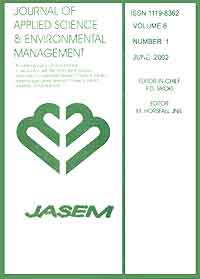
|
Journal of Applied Sciences and Environmental Management
World Bank assisted National Agricultural Research Project (NARP) - University of Port Harcourt
ISSN: 1119-8362
Vol. 22, No. 5, 2018, pp. 791-795
|
 Bioline Code: ja18140
Bioline Code: ja18140
Full paper language: English
Document type: Research Article
Document available free of charge
|
|
|
Journal of Applied Sciences and Environmental Management, Vol. 22, No. 5, 2018, pp. 791-795
| en |
Evaluation of Heavy Metals Level and Proximate Analysis of Common Fruits from Selected Markets in Lagos, Nigeria
ROTIMI, OT; OGUNYEBI, AL & FINGESI, TS
Abstract
This study was carried out to determine the heavy metals concentration and proximate composition
of five different fruits collected in triplicates from five different markets in five local government areas of Lagos state
in Nigeria and extracted using Double Acid Extraction Method. Heavy metals concentration was performed using
Atomic Absorption Spectrophotometer and proximate composition was determined by Association of Official
Analytical Chemistry (AOAC) method. Results showed that the highest level of lead was found in carrot (0.18 ± 0.7)
while pineapple (0.10 ± 0.0) had the lowest level of lead. The fruits in this study may have been polluted with lead
through pollutants in irrigation water, farm soil or due to pollution from the highway traffic. Chromium, Cadmium and
Copper was observed to be low in all the fruits analyzed, which is still within the safe limit set by FAO/WHO. Zinc
had the highest concentration (3.99 ± 0.8) in water melon; proximate analysis indicated significant variability in the
constituents contained in the fruits studied (moisture content, carbohydrate and crude fat in descending order). The
highest moisture content was found in watermelon (91.3%) and the highest crude protein in carrot (1.138%). The
concentrations of the toxic heavy metals are within the tolerable limits of some regulatory authorities. However, there
is need for continuous monitoring of heavy metals and proximate analysis in fruits because, fruits are the main sources
of food supplements for humans in many parts of the world and are considered as bio-indicators of environmental
pollution.
Keywords
Heavy metals; analysis; fruits; food quality
|
| |
© Copyright 2018 - Rotimi et al.
|
|
